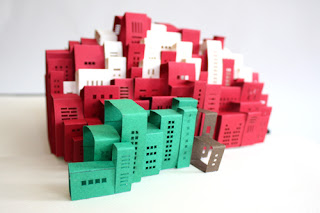








Interactivity was a big focus for the duration of the Summer I session. I found it very invigorating and a great way to be more creative. With project one, we had to choose a MAKE project that was on the magazine’s website and create a QR code interactive poster that didn’t give away the project. The challenge in it was to make sure the viewer was able to be curious enough to scan the code and continue to do the project. I enjoyed incorporating the QR code into my design with the word ‘glow.’ I chose a ‘random candle screen’ as my MAKE project. Pixels were a part of the inspiration for the project so I tried to incorporate pixels with a glowing effect to try and let the viewer get an idea of what they might see without letting them know that they are actually going to make it.
The second project was a book cover that folds out into a poster. I think this was my favorite project out of the three we did during the session. I knew already what book I wanted to do, Memoirs of a Geisha, and kind of had an idea of what I wanted to create. It was a lot of fun to play with folds to make everything work together like an origami piece. It took many hours to get the final piece together, but I like how it came together very much. I had one side of the poster be purely oriental pattern that was straight from actual kimonos. The other side of the poster, the main piece, was an image of Japanese landscape and with a war plane from WWII. I wanted to get the beauty aspect of Japan into the image, while at the same time allowing the viewer to see that the story isn’t just about beauty at the same time.
The Lego project, our third and final one, was one that could be either very complicated or very simple. I chose the very simple route. I combined post cards and the poster and tried to make them work seamlessly. It turned out to be successful. We had to pick a building from the Lego architecture series. I chose the Empire State Building. I made a simple vector image out of line to make the building. I wanted a clean, simple image for my finished piece. The postcards feature numbers on the front. They seem random at first, but then when you peel them off of the poster, the other side shows informative facts that are relevant to the number and the Empire State Building.
Overall, I found this class to be one of my most stimulating design classes so far. I enjoyed it a lot and was very happy to come to class everyday. I think that the interactivity part of the projects was a huge part of making my work successful this semester. I think that I will explore interactivity in my future projects and I do intended to revisit some of the projects in the future.








































